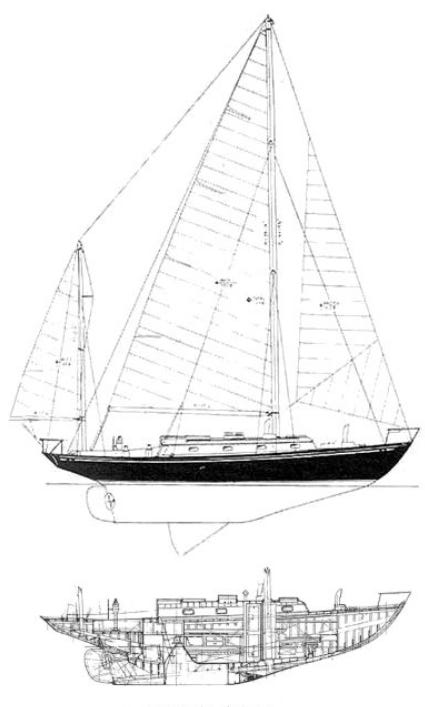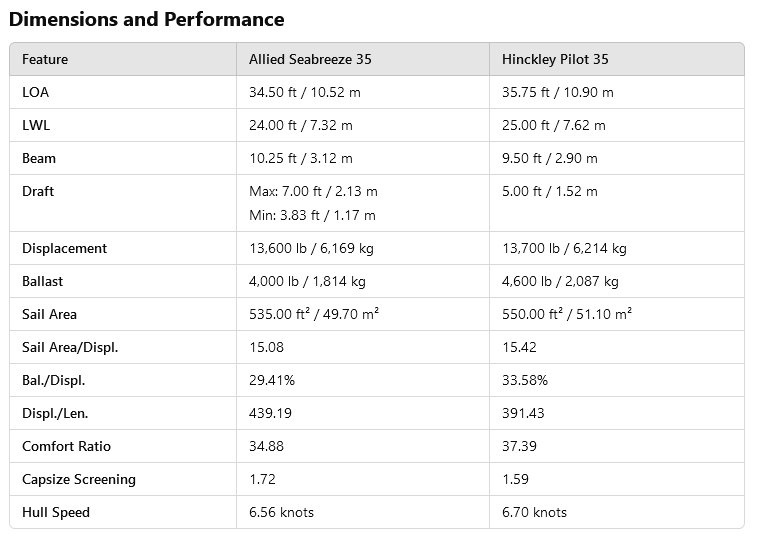Hinckley Pilot vs Allied Seabreeze?
Classic twins with very different price tags—which one’s right for you?
There’s nothing better than dreaming about sailboats, hunting for sailboats, and, of course, sailing them. If you’re boat shopping, the choices can feel endless—but there’s a boat for everyone. If a well-priced classic is calling your name, the Hinckley Pilot 35 and Allied Seabreeze 35 are strong contenders. They’re both stunners, and they both deliver on sailing joy. On the surface, they seem pretty similar, but when it comes to the real costs—buying, maintaining, and upgrading—that’s where the story takes a turn.
Back in October, we profiled a beautifully maintained Allied Seabreeze 35, Snowfish, and not long after the video was released, she sold. The owner had poured a lot of love (and upgrades) into her but ultimately needed a bigger boat for long-distance adventures.
The moment Canadian Ken and I laid eyes on Snowfish, we couldn’t help but think Hinckley Pilot 35. The lines, the sheer, the elegant overhangs—it was all there. And stepping below? She even had that unmistakable Hinckley “feel.”
So, just how similar are these two classics? Let’s start at the beginning—who designed them and where did they come from? Check out the breakdown in the chart below.
Designed by MacLear & Harris, the Allied Seabreeze 35 has a lot in common with the Sparkman & Stephens-designed Hinckley Pilot 35—but the big difference? The Seabreeze has a centerboard. And if you find one with a bronze board, run—don’t walk—to buy it! (Early models came with a preferred 380-pound bronze centerboard, while later ones switched to aluminum.) With the board up, the Seabreeze draws just 3.83 feet, compared to the Pilot’s 5 feet.

Here’s how their paths crossed. Frank MacLear started at Sparkman & Stephens in 1948 before spending the ’50s sailing OPBs (Other People’s Boats). By 1959, he teamed up with fellow S&S alum Robert Harris—who’d been there from 1950 to 1957—to launch their own design firm, MacLear & Harris. By 1962, the Seabreeze plans had left their drafting table, and hull #1 splashed in 1963. Meanwhile, the first fiberglass Pilot hit the water in 1962, following about eight wooden Pilots built between 1956 and 1962.
If this origin story weren’t blurry enough, the Seabreeze has also been dubbed the "fiberglass Finisterre." If that name rings a bell, it should—Finisterre was an S&S-designed legend, winning three consecutive Newport-Bermuda Races in the late '50s and early '60s (the only boat ever to do so). While Harris was at S&S he apparently worked with Olin Stephens on her design and it’s been said that Finisterre was the prototype for the Seabreeze…
Since the Hinckley Pilot 35 and Finisterre were S&S creations—and both MacLear and Harris spent time there—it’s easy to see how design elements cross-pollinated among these three boats, giving them a shared DNA. Beyond their good looks, the performance between the Pilot and the Seabreeze—at least on paper—is nearly identical.
A few things stand out, but honestly, we’re splitting hairs here.
First, the Seabreeze’s beam is ¾ of a foot wider than the Pilot’s, giving it a touch more room down below, but the Pilot has a slightly longer waterline, which offsets this a bit. Second, on paper, the Pilot should be a bit quicker in light air with a Sail Area/Displacement of 15.42 compared to the Seabreeze’s 15.08. And when the breeze picks up, the Pilot stiffens up better, thanks to a Ballast/Displacement ratio of 33.58 vs. the Seabreeze’s 29.41—though, truth be told, you’d have to be a hell of a sailor to actually feel that difference.
As for comfort at sea, both boats score well with ratios above 30, meaning they’ll handle ocean swells with ease and have a nice motion, in case you’re prone to seasickness and care about such things. And when it comes to speed, it’s practically a dead heat. Some will argue the Pilot is faster, others will swear by the Seabreeze. The New England PHRF numbers tell one story: 189 for the Seabreeze, 195 for the Pilot, meaning the Allied is theoretically quicker and “owes” the Hinckley six seconds a mile—or, in real-world terms, the difference between one well-executed tack and a sloppy one…
What’s the current market like for these two boats?
Well, as of February 14th, there were four Hinckley Pilot 35s and three Allied Seabreeze 35s on the market.
Snowfish sold for her full asking price of $19,500 (see the BoatFools Market Report), proving you can find a Seabreeze for under $28,000—you just need to keep your eyes peeled (one recently came and went that was listed for $9,500 - but she needed some attention, maybe a lot!). Now, I’m sure there are Hinckley Pilots out there for less than $48,500, but odds are, they’d be in pretty rough shape. Hinckley owners don’t let go of their boats lightly, and generally speaking, they’re well cared for and command a premium. Both boats are stunners in their own right, and here’s a fun fact: 135 Allied Seabreezes were built compared to 128 Hinckley Pilots.
COST OF OWNERSHIP
So, these numbers are very general and will vary wildly depending on your location, how much DIY work you can do, and the type of sailing you’re planning on doing (intended use!), etc. So, take these with a grain of salt and adjust them accordingly.
The Finish Line
The Hinckley Pilot 35 is more expensive across the board—higher purchase price, insurance, maintenance, and refit costs (should this come to pass). The Allied Seabreeze 35 offers a more budget-friendly classic cruising experience, with significantly lower upfront costs and annual ownership costs. While still a proper bluewater boat, the Seabreeze offers much of the same capability without the Hinckley price tag.
If you're looking for a high-end classic with prestige, the Hinckley Pilot 35 is the way to go. If you have champagne taste but are on a Budweiser budget (like most of us!), the Allied Seabreeze is a stellar choice. At the very least, you’d know that some sailors might mistake your boat for a Hinckley Pilot, your Seabreeze will sail just as well, and on the right day, you might even pass a Pilot out on the bay—and that, my friends, is worth its weight in gold. But, in the end, either boat will steal your heart.
That’s our take. What’s yours?
SOLD!
We profiled this this beautiful Vineyard Vixen 29, Banshee, down in Duxbury, MA, a couple of weeks ago and she just sold for its full asking price of $10,000. It is such a sweet boat. Glad she found a new home! Congratulations to the new owner! See The BoatFools Market Report and see the video of her here.
Don’t forget to check out THE BOATFOOLS MARKET REPORT for updates on recent sales, price changes, etc. It’s a live document and will be updated as necessary.
What type of sailboat would YOU like us to try and profile? Leave us a comment below!
SAILING STORIES FOLLOWING
If you’re into offshore racing and follow the Newport Bermuda Race, check this out - includes the incident report from the 2024 race: NEWPORT BERMUDA
Sailing Apps? Here are some good ones:


If you have some great app ideas to share, leave a comment below!














Great escape article on a cold winter day. While its deep draft limits where one may sail, I like the way my Rhodes 27 stiffens with a good breeze.
Great article.
Warm weather coming soon!